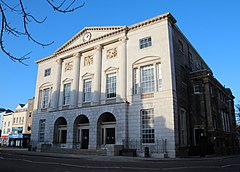Chelmsford
Chelmsford a city in the county of Essex, England. It is 32 miles (51 km) northeast of London, about halfway to Colchester. It is nearly in the centre of the county and it is the county town of Essex, but it is not the biggest or the oldest town in the county. It is the centre of the borough of Chelmsford, which is a bigger place than the city.
| Chelmsford | |
|---|---|
 Shire Hall | |
| Location within Essex | |
| Population | 111,511 (2011 Census)[1] |
| OS grid reference | TL713070 |
| District | |
| Shire county | |
| Region | |
| Country | England |
| Sovereign state | United Kingdom |
| Post town | CHELMSFORD |
| Postcode district | CM1, CM2, CM3 |
| Dialling code | 01245 |
| Police | Essex |
| Fire | Essex |
| Ambulance | East of England |
| UK Parliament | |
Chelmsford has the smallest cathedral in England. John Dee, who wrote the English version of Euclid, went to the Cathedral school in the sixteenth century. Chelmsford is also home to some of the Anglia Ruskin University campuses.
People
changeThe number of people living in the borough is about 170,000; about 115,000 of those live in the city.
Transport
changeAbout 20,000 people from Chelmsford travel to London every weekday. Another 20,000 people work in Chelmsford who live outside the city. This makes Chelmsford the busiest "ordinary" railway station in England (not including junctions and terminuses). (The busiest of all is Clapham Junction railway station).
The A12 road from London, which the Romans first built between London and Colchester, went through the town, but now goes around the east, so the number of cars in the town is smaller.
Industry
changeChelmsford has been an important centre for industry since the 19th century. It became home to the UK's first electrical engineering works (in 1878), and its first ball bearing factory (in 1898).
In 1898, Guglielmo Marconi, the "father of radio" opened the World's first radio factory in Hall Street, with about 50 workers. In 1920 the factory was also the home of the first official sound (radio) broadcasts (radio people could listen to from a long way) in the United Kingdom. In 1922 the world's first regular radio broadcasts started at the Marconi Research Centre at Writtle near Chelmsford.
Places of Interest
changePlaces of interest in and near Chelmsford are for example Writtle, where Robert I of Scotland was perhaps born, and Pleshey, where the ruins of a castle in William Shakespeare's play Richard II are.
Hylands House and Park, west of the town, is an old country house. People can visit it, and in the last years it has been the place for a popular yearly music festival, the V Festival.
The old Palace of Beaulieu is also nearby.
Chelmsford is also famous for being the birthplace of radio, Marconi was an Italian man who invented the radio and had his first factory in Chelmsford.
History
changeIn 1199 the Bishop of London gave a Royal Charter (a special paper) for the town to have a market. But there have been people living here since pre-historic times. The Romans also lived in Chelmsford. An octagonal temple is under the Odeon roundabout.
In World War II bombs hit Chelmsford a number of times. The worst single loss of life happened on Tuesday 19 December 1944. The 367th V-2 rocket which hit England fell near the Hoffmans' ball bearing factory. 39 people were killed and 138 hurt, 47 of them badly. A lot of buildings were destroyed and hundreds more were damaged.
Geology
changeFrom over 600,000 years ago, the early River Thames went through the place where Chelmsford is now, from Harlow to Colchester. Then it went over today's North Sea and went into the Rhine.
Twin towns
changeChelmsford is twinned with these:
People from Chelmsford
change- Anne Knight (born 1786), anti-slavery campaigner and pioneer of feminism
Nearby places
change- Great Baddow
References
change- ↑ "2011 Census - Built-up areas". ONS. Retrieved 11 August 2013.
Other websites
change- Chelmsford Borough Council Archived 3 September 2005 at the Wayback Machine
- Diocese of Chelmsford
- 21st World Scout Jamboree Archived 4 October 2002 at the Wayback Machine
